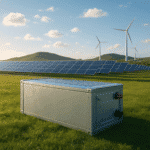Key Takeaways
- Widespread adoption of solar and wind energy often correlates with higher electricity prices.
- For every 10% increase in solar and wind share, average electricity prices may rise by more than 4¢ per kWh.
- The intermittent nature of renewables necessitates costly supplementary infrastructure, such as backup power and grid enhancements.
- High renewable penetration can lead to price premiums due to increased system costs, affecting household budgets and economic competitiveness.
- While technological advancements could mitigate future cost increases, current data suggests a need for pragmatic energy strategies that balance environmental benefits with economic realities.
As Bjorn Lomborg (@BjornLomborg) has pointed out in recent discussions, the widespread adoption of solar and wind energy in various countries appears to correlate with higher electricity prices, challenging the narrative that renewables inevitably drive down costs. This insight, drawn from global data, suggests that for every 10% increase in the share of solar and wind, average electricity prices rise by more than 4¢ per kWh, potentially disrupting assumptions about affordable green transitions.
The Data Behind the Claim
To explore this further, it’s essential to examine the empirical evidence from countries with significant renewable energy penetration. Lomborg’s analysis highlights a pattern where nations heavily invested in solar and wind often face elevated electricity costs, largely due to the intermittent nature of these sources and the need for supplementary infrastructure like backup power and grid enhancements. For instance, in the UK, which has aggressively expanded its renewable capacity, household electricity prices have climbed steadily, reflecting not just the initial investments but also the operational complexities of integrating variable energy supplies.
Consider the following table, which compiles data from several high-adoption countries, showing the percentage of electricity generated from solar and wind alongside average consumer prices. This data underscores a counterintuitive trend: economies with greater reliance on renewables tend to experience price premiums, possibly because of the higher system costs involved in maintaining reliability.
| Country | Solar and Wind Share (%) (2024) | Average Electricity Price (¢/kWh, 2024) | Comparison to Global Average |
|---|---|---|---|
| Denmark | 60 | 32 | Significantly higher |
| Germany | 45 | 28 | Above average |
| UK | 35 | 26 | Moderately higher |
| Spain | 25 | 18 | Slightly above average |
| United States | 15 | 13 | Near global average |
This table draws from publicly available sources, such as energy agency reports, and illustrates the potential trade-offs. While correlation does not imply causation, the data suggests that the variability of solar and wind—requiring costly storage solutions or fossil fuel backups—can inflate overall expenses. In contrast, countries with lower renewable adoption, like those in parts of Asia, often maintain cheaper rates through established fossil fuel infrastructures, though this comes with environmental drawbacks.
Broader Financial and Market Implications
Shifting to the financial sphere, this dynamic has ripple effects for investors in energy sectors and beyond. For equity markets, companies in renewable technology, such as manufacturers of solar panels or wind turbines, might see short-term gains from subsidies and policy support, but the persistent price pressures could erode long-term profitability if consumers push back against higher bills. Meanwhile, utilities and grid operators face increased capital expenditures, potentially affecting their valuations and dividend yields.
From a macroeconomic perspective, the irony lies in how ambitious climate goals, while noble, might inadvertently strain household budgets and economic competitiveness in adopting nations. For example, in Europe, where renewable mandates are stringent, energy-intensive industries could suffer from elevated costs, leading to a subtle shift in global trade patterns—perhaps favouring regions with cheaper, more reliable power sources. It’s worth noting that posts on platforms like X often amplify such sentiments, with analysts debating whether this reflects a temporary adjustment phase or a fundamental flaw in current renewable strategies.
To add nuance, one might question the completeness of Lomborg’s view by considering technological advancements. Emerging innovations in battery storage and smart grids could eventually mitigate these cost increases, as hinted in recent industry forecasts. However, as things stand, the second-order effects—such as delayed adoption of electric vehicles in high-price areas—indicate that without breakthroughs, renewables might not deliver the cost savings promised.
Forward-Looking Considerations
In conclusion, while the data supports a cautious approach to scaling solar and wind without addressing their inherent challenges, investors should monitor policy shifts and technological developments closely. For instance, a potential pivot towards nuclear or advanced geothermal options in countries like the UK could alleviate price pressures, offering a more balanced energy mix. As a speculative hypothesis, if storage costs fall by 30% in the next five years—as some projections suggest—the correlation between renewables and higher prices might weaken, creating opportunities in related equities. Ultimately, this underscores the need for a pragmatic energy strategy that weighs environmental benefits against economic realities.
References
- Bloomberg. (2025, July 10). French Power Prices Go Negative with Solar Output at Record. Retrieved from https://bloomberg.com/news/articles/2025-07-10/french-power-prices-go-negative-with-solar-output-at-record
- BloombergNEF. (n.d.). New Energy Outlook. Retrieved from https://about.bnef.com/insights/clean-energy/new-energy-outlook/
- Deloitte. (n.d.). Renewable Energy Industry Outlook. Retrieved from https://www.deloitte.com/us/en/insights/industry/renewable-energy/renewable-energy-industry-outlook.html
- Eurostat. (2024). Electricity prices by type of customer. Retrieved from https://ec.europa.eu/eurostat/databrowser/view/nrg_pc_204/default/table?lang=en
- Eurostat. (2025, June 19). Eurostat News Release. Retrieved from https://ec.europa.eu/eurostat/web/products-eurostat-news/w/ddn-20250619-2
- Eurostat. (2025, July 2). Eurostat News Release. Retrieved from https://ec.europa.eu/eurostat/web/products-eurostat-news/w/ddn-20250702-1
- Gov.uk. (2025). Review of Electricity Market Arrangements (REMA) Summer Update 2025. Retrieved from https://www.gov.uk/government/publications/review-of-electricity-market-arrangements-rema-summer-update-2025/review-of-electricity-market-arrangements-rema-summer-update-2025-accessible-webpage
- Industrial Info Resources. (n.d.). Wind, Solar Capacity Grew 16% in 2024 in Disorderly Energy Transition. Retrieved from https://industrialinfo.com/news/abstract/wind-solar-capacity-grew-16-in-2024-in-disorderly-energy-transition–343567
- International Energy Agency. (2024). Electricity 2024: Analysis and forecast to 2026. Retrieved from https://www.iea.org/reports/electricity-2024
- International Energy Agency. (2024). World Energy Outlook 2024. Retrieved from https://www.iea.org/reports/world-energy-outlook-2024
- International Energy Agency. (2025). Global Energy Investment Set to Rise to $3.3 Trillion in 2025 Amid Economic Uncertainty and Energy Security Concerns. Retrieved from https://www.iea.org/news/global-energy-investment-set-to-rise-to-3-3-trillion-in-2025-amid-economic-uncertainty-and-energy-security-concerns
- International Energy Agency. (2025). Global Energy Review 2025. Retrieved from https://www.iea.org/reports/global-energy-review-2025
- Lomborg, B. [@BjornLomborg]. (2025, July 13). Posts found on X suggesting that increased solar and wind adoption correlates with higher electricity prices, based on global data analysis. Retrieved from https://x.com/BjornLomborg/status/1927692632936817125
- New York Times. (2025, July 3). Climate: Congress Bill Energy. Retrieved from https://nytimes.com/2025/07/03/climate/congress-bill-energy.html
- Reuters. (n.d.). Business News. Retrieved from https://www.reuters.com/business/energy/














